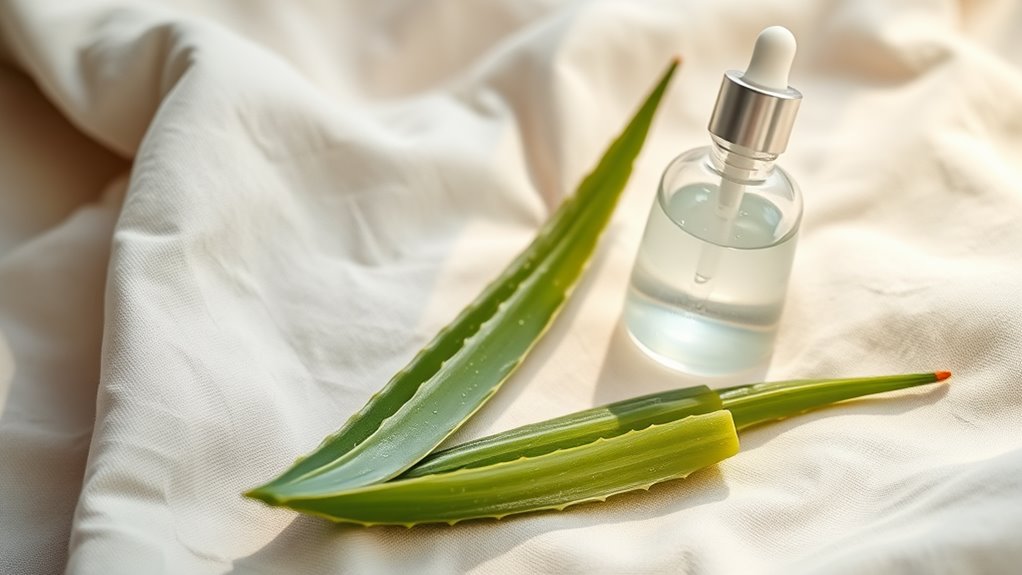Tried and Tested- Best Tips for Redness, Sensitivity & Soothing Routines
If you’re dealing with skin redness and sensitivity, start by identifying triggers like irritants or UV exposure, then incorporate soothing ingredients such as aloe vera and niacinamide to calm inflammation. Gently cleanse twice daily, moisturize with hypoallergenic creams, and apply SPF 30+ sunscreen. Try natural techniques like chamomile compresses and build habits like staying hydrated. Explore these strategies further to achieve a balanced, resilient complexion.
Key Takeaways
- Identify and avoid common triggers like harsh chemicals and allergens to prevent skin redness and sensitivity.
- Incorporate soothing ingredients such as aloe vera and chamomile to calm inflammation and reduce irritation.
- Follow a gentle daily routine with mild cleansers and ceramide-rich moisturizers to maintain skin barrier health.
- Apply natural techniques like oatmeal baths or cool compresses for immediate relief from sensitivity symptoms.
- Adopt long-term habits, including daily sunscreen use and hydration, to promote a resilient and balanced complexion.
Common Causes of Skin Redness
While skin redness often signals an underlying issue, you might experience it from common triggers like environmental irritants, such as pollution or harsh chemicals, which inflame the skin. Another common cause is ingredient sensitivities, which can occur due to specific components in skincare products and lead to further irritation.
Sensitivity amplifies this, as your skin’s barrier weakens from allergens like pollen or certain fabrics, heightening reactions that cause persistent redness.
Everyday factors, including temperature fluctuations or UV exposure, further exacerbate sensitivity by dilating blood vessels and increasing inflammation.
To address these, incorporate practical soothing routines: start with a gentle, fragrance-free cleanser to remove irritants without stripping moisture, then apply a cooling gel with calming ingredients like oat extract to reduce heat and soothe affected areas.
Evidence shows consistent routines, such as nightly application of barrier-repairing creams, help minimize sensitivity and prevent redness flare-ups.
Additionally, integrating soothing products into your daily regimen, as suggested by experts, can further promote a calm and balanced complexion.
Identifying Signs of Sensitive Skin
You notice redness symptoms like persistent flushing or blotchy patches, which often signal sensitive skin.
You’ll also spot irritation indicators such as stinging, itching, or dryness after using certain products.
Recognizing these signs helps you choose the right skincare routine to manage and prevent flare-ups.
For instance, a seven-day specialized routine can demonstrate noticeable enhancements in skin calmness and resilience, as detailed in personal experiences.
Additionally, incorporating soothing routines is key to maintaining skin health and comfort.
Redness Symptoms
Sensitive skin often reveals redness through telltale signs like persistent flushing, itching, or visible inflammation. You might experience your cheeks or nose turning a vivid red after triggers such as heat, wind, or certain products, signaling your skin’s barrier is compromised. This isn’t just cosmetic; it’s your body’s response to irritation, potentially linked to conditions like rosacea. To identify these effectively, refer to the table below for a practical overview based on dermatological insights.
| Sign | What it Looks Like | Practical Tip |
|---|---|---|
| Persistent Flushing | Prolonged redness, especially on face | Apply a gentle, fragrance-free moisturizer |
| Itching | Scratchy sensation on affected areas | Use hypoallergenic fabrics against skin |
| Visible Inflammation | Swollen, warm patches | Incorporate anti-inflammatory ingredients like aloe vera |
| Dry Patches | Rough, red spots with flakiness | Hydrate with ceramide-based products |
Recognizing these helps you adapt your routine proactively.
Irritation Indicators
Irritation indicators in sensitive skin often emerge as immediate reactions, such as stinging, burning, or tightness, triggered by common irritants like harsh chemicals or environmental factors.
You may also notice itching, redness, swelling, or persistent dryness, signaling your skin’s barrier is under stress. These signs, backed by dermatological research, can appear suddenly or build gradually, like flaking after exposure to wind or pollution.
To identify them effectively, track your reactions in a simple diary, noting triggers such as fragranced products or extreme temperatures. If you experience frequent irritation, perform patch tests on new items before full use.
Evidence shows early detection prevents escalation; for instance, switching to gentle, pH-balanced formulas can minimize discomfort. By staying vigilant, you build a personalized routine that soothes and protects your skin, fostering resilience and comfort.
Essential Soothing Ingredients for Skincare
When you’re dealing with redness and sensitivity, you’ll find that incorporating redness-reducing ingredients like aloe vera can quickly calm inflammation.
It’s also crucial to include sensitivity-soothing options such as ceramides to strengthen your skin’s barrier.
These choices, backed by dermatological studies, help you maintain a balanced and resilient complexion.
For quick relief, incorporate skin care products that are specifically designed to alleviate irritation.
For added relief, consider natural remedies from your kitchen to effectively address irritation and inflammation.
Redness-Reducing Ingredients
While skin redness can disrupt your daily routine, key ingredients like aloe vera and chamomile offer proven relief by calming inflammation and strengthening the skin’s barrier.
These natural powerhouses reduce redness through their anti-inflammatory effects, backed by studies showing aloe vera’s hydrating polysaccharides and chamomile’s flavonoids minimize irritation.
To build an effective routine, focus on evidence-based choices that target visible redness without overwhelming your skin.
-
Aloe Vera: Apply this gel directly to soothe flare-ups, as its enzymes reduce swelling and promote healing quickly.
-
Chamomile: Use in serums or creams; its bisabolol compound calms redness and protects against environmental stressors.
-
Niacinamide: Incorporate this vitamin B3 derivative to strengthen your barrier, diminishing redness while improving texture over time.
Sensitivity-Soothing Options
For sensitive skin, essential ingredients provide reliable relief by calming reactions and bolstering the skin’s barrier, as supported by clinical studies.
You can incorporate soothing options like aloe vera, which research shows reduces inflammation and hydrates effectively, or chamomile extract to minimize irritation and redness.
Oat-derived beta-glucan strengthens your barrier, backed by trials demonstrating improved resilience against environmental stressors.
Niacinamide helps regulate sensitivity by enhancing ceramide production, making it a practical daily addition.
Always patch-test new products and choose formulations free from potential irritants like fragrances.
By integrating these ingredients into your routine, you’ll notice calmer, more balanced skin—empowering you to manage sensitivity proactively.
Daily Routines to Calm Irritated Skin
To calm irritated skin effectively, adopt these simple daily routines that draw on evidence-based practices.
These habits, backed by dermatological studies, target inflammation and enhance your skin’s natural barrier. Focus on consistency to see results, as research highlights the benefits of routine care for sensitive skin. To maximize benefits, avoid common skincare mistakes such as over-exfoliating.
-
Gently cleanse twice daily: Use a mild, pH-balanced cleanser to remove dirt without disrupting your skin’s microbiome, reducing irritation as per clinical trials.
-
Moisturize immediately after: Apply a lightweight, hypoallergenic cream to restore hydration and fortify the barrier, which evidence shows prevents flare-ups.
-
Incorporate soothing techniques****: End your routine with a cool compress or brief misting to alleviate redness, drawing from studies on thermal regulation for sensitive skin.
To address specific concerns like redness around the nose, explore soothing remedies that help restore your skin’s natural balance.
Top Product Recommendations for Relief
After building on your daily routines, you can select evidence-based products that target redness and sensitivity.
Opt for a ceramide-rich moisturizer, as clinical studies confirm it restores the skin barrier and reduces irritation. Choose a gentle, sulfate-free cleanser with soothing ingredients like oat extract, which minimizes inflammation without stripping natural oils.
For sun protection, pick a mineral-based sunscreen with zinc oxide; research shows it shields against UV rays that exacerbate redness.
Incorporate a niacinamide serum, proven in trials to improve skin texture and calm sensitivity by regulating oil production. Moreover, niacinamide is beneficial for acne-prone skin as it aids in treating and preventing breakouts.
Avoid fragranced products, as they can trigger reactions. Always read labels for hypoallergenic formulas and perform patch tests.
These practical choices, backed by dermatological evidence, deliver reliable relief and enhance your skin’s resilience. Consult professionals for personalized advice to ensure long-term results.
Additionally, these products may also help reduce puffy eyes by alleviating associated inflammation and swelling as per effective treatments.
Natural Techniques for Reducing Sensitivity
While commercial products provide a solid foundation, natural techniques offer gentle, effective ways to ease skin sensitivity. You can harness everyday ingredients to calm your skin and reduce irritation, drawing on evidence from studies showing their anti-inflammatory benefits. This approach aligns with findings that promote natural remedies for achieving glowing skin.
These methods are simple to integrate, helping you maintain a balanced routine without overwhelming your senses.
Furthermore, you can transform your beauty routine by incorporating everyday kitchen ingredients to provide more natural alternatives for skincare.
-
Apply aloe vera gel****: Its cooling, anti-inflammatory compounds quickly soothe redness and promote healing, as supported by dermatological research.
-
Use chamomile compresses****: The antioxidants in chamomile tea reduce sensitivity and inflammation, making it a proven natural remedy for irritated skin.
-
Incorporate oatmeal baths****: Finely ground oatmeal creates a protective barrier that locks in moisture and eases discomfort, backed by traditional and clinical evidence.
Long-Term Habits for a Balanced Complexion
Building long-term habits helps you sustain the benefits of natural techniques by fostering a resilient, balanced complexion. Furthermore, increased water consumption can transform skin appearance for a radiant glow, as supported by hydration insights.
To start, incorporate daily sunscreen use—SPF 30 or higher—to shield your skin from UV damage, as studies show it reduces long-term redness. You’re also maintaining hydration by drinking at least eight glasses of water daily, which supports skin barrier function and minimizes sensitivity.
Adopt a consistent routine with gentle, non-irritating products, applying them actively each morning and night. Include stress-reducing activities like yoga, backed by research linking lower cortisol levels to improved skin health.
Monitor your diet for anti-inflammatory foods, such as omega-3-rich fish, to promote healing. Track progress with a skin journal, adjusting habits based on real-time responses for lasting results.
These practices ensure you maintain a calm, even complexion over time.
Moreover, adopting five practical strategies can provide immediate coping mechanisms for a holistic approach to well-being.

